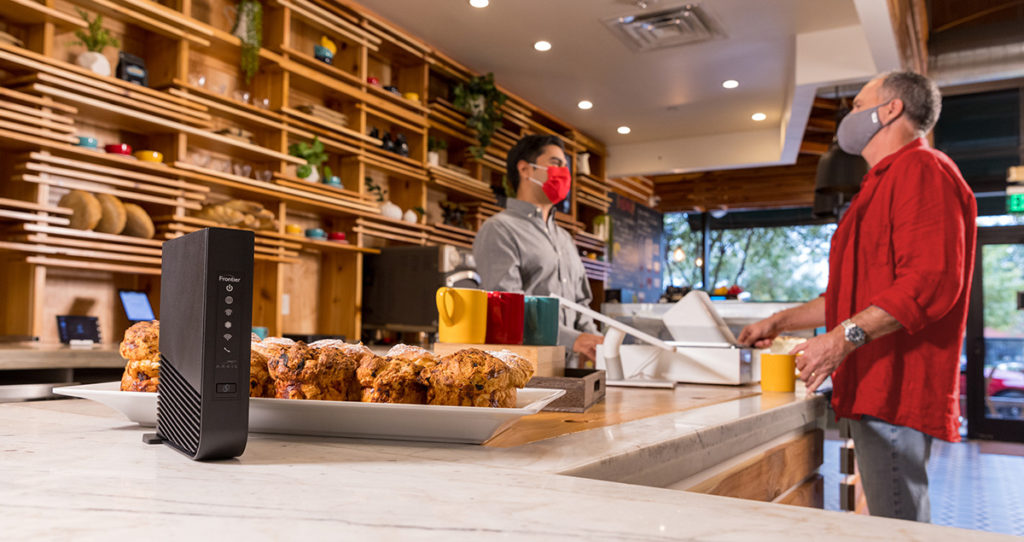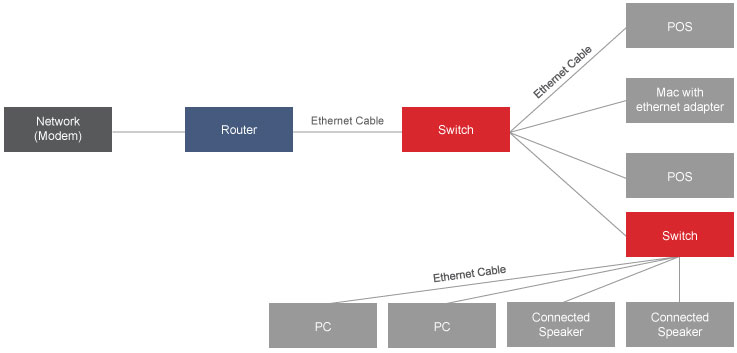Why Use an Ethernet Connection for Your Business

At some point, when your business connectivity gets more complex—more users, more applications, more bandwidth—consider changing your internet connections to an ethernet connection. Ethernet is a connected internet technology, and while using wires may seem anachronistic, they make sense for many businesses as they can exist hand in hand with the wireless connections you’ll still need to have for selected devices. Ethernet provides additional security, speed and reliability you can’t always get with wireless connections.
What is ethernet?
At your home, your devices likely access the internet using a Wi-Fi router. With ethernet, devices use wires to connect to the router (or switch). Wi-Fi offers flexibility: When you want to move your computer, more wires aren’t helpful. But here’s the key difference: Many business devices stay in place, so investing in setting up business ethernet lets you take advantage of ethernet without the residential drawbacks of wires.
3 major benefits of ethernet
1. Speed
According to VSS Monitoring, Wi-Fi isn’t slower than using ethernet on the same network in theory, but Wi-Fi is subject to greater latency and obstacles, making ethernet typically faster in practice. Wi-Fi uses radio waves to transmit data over the air. Radio waves are subject to interference, including from other devices and physical barriers like walls. Assuming you’re using the proper equipment, ethernet connections suffer less interference than Wi-Fi connections do. Additionally, ethernet currently supports higher max speeds—so ethernet is great for a 2 Gig connection.
2. Security
Wi-Fi’s unparalleled convenience of connecting any device in range means a tradeoff in security. With Wi-Fi, bad actors can intercept your Wi-Fi password and access your network, or even spoof the network itself. Ethernet eliminates such risks by requiring physical connections to your network.
3. Reliability
Ethernet is often more reliable than Wi-Fi for the same reasons it’s faster and more secure. Not relying on radio waves removes many potential obstacles, including interference and blocked signals from physical barriers. A stable connection means a reliable connection, and nothing is more stable than a cord plugged directly into your device. Ethernet has fewer potential points of failure, and the points that do exist are easier to troubleshoot.
How to set up ethernet
Though it may seem complex, setting up ethernet is straightforward, and high-quality equipment is affordable.
You’ll need:
- Ethernet switch(es) – Ethernet switches connect to your modem and are used to provide ports to connect devices to ethernet. Ethernet switches allocate bandwidth as devices need it, meaning they provide optimized performance. You’ll need switches totaling enough ports to connect every device you want to have a wired connection.
- Ethernet cables – These look like landline phone cords, but they’re different. Don’t try to repurpose old phone cords, and do your research for your particular modem before buying new cables. You need cables made for the purpose of connecting to the internet. Ethernet cables are coded with names like “Cat6” or “Cat8.” “Cat” means “category,” and higher numbers tend to indicate higher possible speeds. Look for “shielded” Cat6 or Cat6a, gigabit ethernet cables, which have insulation from interference (that’s the shielding) and are fast enough for most purposes (i.e., you’re not running a data center). Measure how far different devices will be from your switch(es) and purchase cord lengths based on that.
Note: Basic ethernet wiring doesn’t require an electrician. You can just use whatever port your business has already and run wires outside the walls from there, using hooks where appropriate. However, if you’re building or remodeling, consider future-proofing by running high-quality shielded ethernet cabling inside the walls, which you should hire a contractor to do.
A very simplified ethernet setup entails just plugging your modem into your switch, then connecting the switch to a device with an ethernet cable. See this guide from Jones IT for a deeper dive into small business network setup.

Ethernet ports look like phone jacks and remain common on Windows devices, but are no longer included on most Apple devices. You can still connect devices that lack a built-in port using an adapter, like a USB gigabit ethernet adapter. (To find one, search “[your device] ethernet adapter.”) Your business’ other devices, like point-of-sale systems, speakers and printers, are likely to have ethernet ports.
The other end of the cable plugs into the ethernet switch. When searching for ethernet switches, you may also encounter splitters or hubs. When breaking down ethernet splitters vs. switches and ethernet switches vs. hubs, in most cases a switch is superior. Switches avoid the pitfalls of both splitters and hubs and allocate traffic according to the devices’ needs. If you have many devices, you can buy larger switches, or even chain switches together.

Do I have to choose between ethernet and Wi-Fi?
Setting up wires can feel permanent, but it shouldn’t! Most businesses don’t choose between ethernet and Wi-Fi, but instead decide which devices to connect using which technology, and when. Sales associates walking around with iPads need Wi-Fi, but a stationary payment device, for example, can add in security by using an ethernet connection. Using ethernet for devices that need it helps free Wi-Fi range for devices that require wireless connectivity.
Keeping Wi-Fi in your setup is as simple as plugging your switches directly into your router (and buying the router, if you need to). Here’s what a setup that allows both Wi-Fi and ethernet might look like:

Incorporating ethernet into your connectivity strategy can improve your network speed, security and reliability, all while helping you take full advantage of a new fiber connection if fiber is available in your neighborhood. Click here to see if Frontier® fiber internet is available at your address.